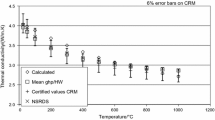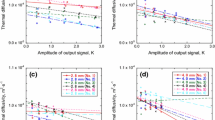Abstract
New techniques have been developed for reducing thermal conductivity data from thermal comparative measurements. The first of these techniques is based on making a Taylor-series expansion of the stack centerline temperature profile. The result is an expression giving the ratio of sample to reference conductivities at any temperature as a function of measured quantities, the stack thermocouple readings and stack element thicknesses. The conventional formula presently used to reduce comparative conductivity data is shown to be a special result of the general analysis. A second technique involves the use of linear least-squares (LS) techniques to derive both the sample and the reference conductivities from the measured data. The LS technique provides the coefficients for a polynomial temperature expansion of the reference and sample conductivities directly. Use of the new techniques is illustrated in a reduction of some comparative data on the conductivities of Pyrex 7740 and Pyroceram 9606. It is shown that a highly self-consistent pair of conductivity functions can be derived for these two commonly used reference materials if the conductivity vs temperature relation for Pyrex is modified slightly from its recommended value. The Pyroceram conductivity results from the comparative measurements are in good agreement with a conductivity derived from pulse diffusivity and differential scanning calorimetry measurements and also in good agreement with the recommended Pyroceram conductivity function.
Similar content being viewed by others
References
J. Francl and W. D. Kingery, J. Am. Ceram. Soc. 37:80 (1959).
R. G. Morris and J. G. Hust, Phys. Rev. 124:1426 (1961).
V. V. Mirkovich, J. Am. Ceram. Soc. 48:387 (1965).
D. R. Flynn, in Mechanical and Thermal Properties of Ceramics, J. B. Wachtman, Jr., ed. NBS Special Publication 303, May 1969, pp. 63–123.
M. J. Laubitz, in Thermal Conductivity, Vol. I, R. P. Tye, ed. (Academic Press, New York, 1969), Chap. 3 (see especially pp. 174–182).
J. N. Sweet, M. Moss, and C. E. Sisson, in Thermal Conductivity 18, T. Ashworth and D. R. Smith, eds. (Plenum, New York, 1985), pp. 43–59
J. V. Beck and J. Arnold, Parameter Estimation in Science and Engineering (John Wiley, New York, 1977), pp. 234–247.
Ref. 7, pp. 228–229.
J. G. Hust and A. B. Lankford, Int. J. Thermophys. 3:67 (1982).
R. P. Tye and L. C. Hulstrom, Presented at 9th Symposium on Thermophysical Properties, Boulder, Colo., June 24–27, 1985, sponsored by the ASME.
The Dynatech Model TCFCM comparative thermal conductivity instrument is manufactured by Dynatech R/D Co., Cambridge, Mass. Reference to a particular product or company implies neither a recommendation nor an endorsement by Sandia National Laboratories or the U.S. Department of Energy, nor a lack of suitable substitutes.
M. Moss, J. A. Koski, and G. M. Haseman, Measurement of Thermal Conductivities by the Comparative Technique, Sandia National Laboratories report SAND 82-0109, 1982. (Available fron NTIS, U.S. Department of Commerce, 5285 Port Royal Rd, Springfield, Va. 22161.)
R. W. Powell, C. Y. Ho, and P. E. Liley, Thermal Conductivity of Selected Materials, NBS Publication NSRDS-NBS8, 1966.
IMSL Fortran Subroutine Library, International Mathematical & Statistical Libraries Inc., Houston, Tex., 77042-3020.
N. R. Draper and H. Smith, Applied Regression Analysis, 2nd ed. (John Wiley, New York, 1981), pp. 307–312.
Ref. 7, pp. 269–289.
Author information
Authors and Affiliations
Rights and permissions
About this article
Cite this article
Sweet, J.N. Establishment of accuracy limits and standards for comparative thermal conductivity measurements. Int J Thermophys 7, 743–754 (1986). https://doi.org/10.1007/BF00503832
Issue Date:
DOI: https://doi.org/10.1007/BF00503832




